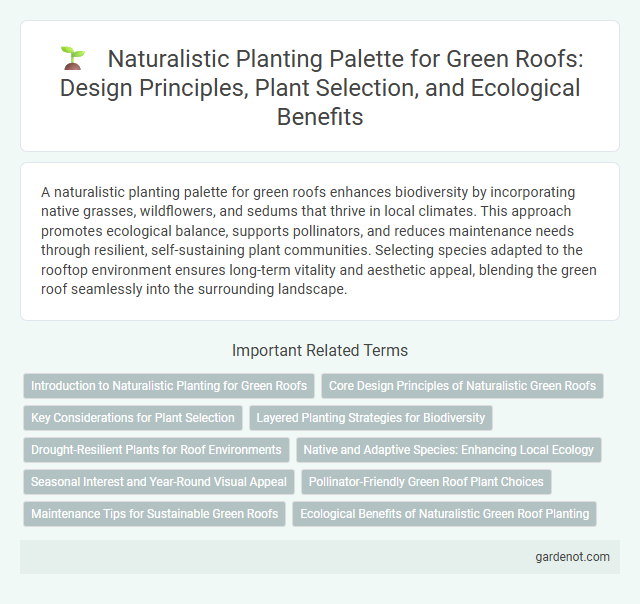A naturalistic planting palette for green roofs enhances biodiversity by incorporating native grasses, wildflowers, and sedums that thrive in local climates. This approach promotes ecological balance, supports pollinators, and reduces maintenance needs through resilient, self-sustaining plant communities. Selecting species adapted to the rooftop environment ensures long-term vitality and aesthetic appeal, blending the green roof seamlessly into the surrounding landscape.
Introduction to Naturalistic Planting for Green Roofs
Naturalistic planting for green roofs emphasizes native and drought-tolerant species that enhance biodiversity and require minimal maintenance. Integrating grasses, wildflowers, and sedums creates resilient ecosystems capable of promoting habitat connectivity and improving urban microclimates. This approach supports stormwater management and boosts ecological benefits while maintaining aesthetic appeal.
Core Design Principles of Naturalistic Green Roofs
A naturalistic planting palette for green roofs emphasizes native species that thrive in local climates, promoting biodiversity and ecological resilience. Core design principles include selecting drought-tolerant plants with deep root systems to optimize water retention and structural stability. Integrating diverse plant heights and textures fosters habitats for pollinators and enhances microclimate regulation on the rooftop ecosystem.
Key Considerations for Plant Selection
Selecting plants for a green roof requires prioritizing drought-tolerant, native species that thrive in shallow soil and withstand extreme temperature fluctuations. Emphasize deep-rooted perennials and sedum varieties to ensure erosion control and low maintenance. Consider plant diversity for ecosystem resilience, promoting pollinator habitats and enhancing biodiversity.
Layered Planting Strategies for Biodiversity
Naturalistic planting palettes in green roofs utilize layered planting strategies that enhance biodiversity by mimicking native ecosystems. Incorporating a diverse mix of grasses, wildflowers, sedums, and shrubs creates microhabitats supporting pollinators, birds, and beneficial insects. These multi-tiered plantings improve soil health, water retention, and ecological resilience in urban environments.
Drought-Resilient Plants for Roof Environments
Drought-resilient plants such as sedum, succulents, and native grasses thrive in green roof environments by minimizing water requirements and enhancing sustainability. These species are adapted to withstand intense sunlight, wind, and limited soil depth, ensuring long-term survival and reducing maintenance costs. Incorporating a naturalistic planting palette with drought-tolerant flora supports biodiversity while improving thermal insulation and stormwater management on urban rooftops.
Native and Adaptive Species: Enhancing Local Ecology
Incorporating a naturalistic planting palette with native and adaptive species on green roofs significantly enhances local ecology by supporting biodiversity, providing habitat for pollinators, and improving ecosystem resilience. Native plants are well-suited to local climate conditions, reducing maintenance needs and water usage while promoting soil health. Adaptive species further contribute to a robust green roof system by thriving under changing environmental stresses, ensuring long-term sustainability and ecological balance.
Seasonal Interest and Year-Round Visual Appeal
A naturalistic planting palette for green roofs emphasizes native perennials, grasses, and wildflowers selected for their seasonal interest, ensuring vibrant blooms in spring and summer, vivid foliage in autumn, and structural forms in winter. Incorporating species such as Sedum, Echinacea, and Carex enhances biodiversity while providing continuous visual appeal throughout the year. This approach supports urban ecology by creating dynamic habitats and reducing maintenance requirements with resilient, climate-adapted plants.
Pollinator-Friendly Green Roof Plant Choices
Selecting a naturalistic planting palette for green roofs enhances biodiversity by prioritizing native flowering plants such as Echinacea purpurea, Solidago spp., and Asclepias tuberosa known for attracting diverse pollinators. Incorporating nectar-rich species like Lavandula angustifolia and Sedum spectabile supports bees, butterflies, and other beneficial insects crucial to urban ecosystems. Diverse structural layers combining grasses, wildflowers, and succulents create a resilient green roof habitat that promotes pollinator health and improves urban ecological connectivity.
Maintenance Tips for Sustainable Green Roofs
Selecting a naturalistic planting palette with native, drought-tolerant species reduces irrigation needs and supports local biodiversity on green roofs. Regular inspection for weeds and proper pruning prevents invasive growth, maintaining plant health and roof integrity. Incorporating organic mulch helps retain soil moisture and suppresses weeds, further enhancing sustainable maintenance practices.
Ecological Benefits of Naturalistic Green Roof Planting
Naturalistic planting palettes on green roofs enhance biodiversity by providing habitats for pollinators, birds, and beneficial insects, promoting urban ecological networks. These plant selections improve stormwater management by increasing water retention and reducing runoff through deep root systems. Ecologically, native and diverse vegetation supports soil health and carbon sequestration, contributing to climate resilience in urban environments.
Naturalistic planting palette Infographic

 gardenot.com
gardenot.com